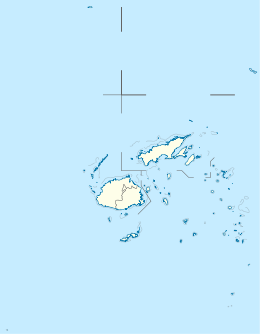This article needs additional citations for verification. (September 2014) |
 Ovalau and nearby islands in the 19th century, with the coast of Viti Levu in the west. | |
| Geography | |
|---|---|
| Location | Fiji |
| Coordinates | 17°41′17″S 178°47′26″E / 17.68806°S 178.79056°E |
| Archipelago | Lomaiviti |
| Adjacent to | Koro Sea |
| Total islands | 1 |
| Major islands | 1 |
| Area | 106.4 km2 (41.1 sq mi)[1] |
| Area rank | 6th |
| Length | 13.7 km (8.51 mi) |
| Highest elevation | 626 m (2054 ft)[2] |
| Administration | |
Fiji | |
| Division | Eastern |
| Province | Lomaiviti Province |
| District | Ovalau |
| Largest settlement | Levuka (pop. 2500) |
| President | George Konrote |
| Demographics | |
| Demonym | Fijians |
| Population | 9100 (2014) |
| Pop. density | 85.526/km2 (221.511/sq mi) |
| Ethnic groups | Native Fijians, Indo-Fijians ; other (Asian, Europeans, other Pacific Islander) |
Ovalau (pronounced [oβaˈlau]) is the sixth largest island in Fiji. It is located in Lomaiviti Archipelago. Situated at 17.70° South and 178.8° East, (60 km north east from the national capital Suva and 20 km off the east coast of Viti Levu), the island is about 13 kilometers long and 10 kilometers wide. It covers a total area of 106.4 square kilometers and has a population of around 9,100, approximately half of the population of Lomaiviti Province over the 1956–2007 period.[3] Levuka, Fiji's former capital, is the largest of 24 towns and villages on the island, and is the only urban area in Lomaiviti.[3] All settlements are coastal, except Lovoni in the interior of the island.[4]
Ovalau is characterized by its rugged topography,[2] with little flat land apart from the Lovoni Valley in the centre of the island. The island is an eroded volcanic crater with a narrow belt of flat to undulating country between the encircling lagoon and the steep crater sides. The highest peaks are Nadelaiovalau, with an elevation of 625 meters, in the east, and Tomuna, 526 meters, in the south. Moturiki is just off the southwest coast of Ovalau. To the north-west is Naigani, and to the east is Wakaya.
- ^ Gillespie, Rosemary G.; D. A. Clague (2009). Encyclopedia of Islands. University of California Press. p. 299. ISBN 0520256492.
- ^ a b Pub. 126 Sailing Directions (Enroute) Pacific Islands (12 ed.). Springfield, Virginia: National Geospatial-Intelligence Agency. 2017. p. 88. Retrieved 24 July 2023.
- ^ a b "Lomaiviti - A Profile of the Demographic and Socio-economic Characteristics of the Population of the Province Based on 1996 and 2007 Census Data". Fiji Bureau of Statistics. 2013. Retrieved 24 July 2023.
- ^ Ramoli, A.; Nunn, Patrick D. (2001). "Naigani Island and its historical connections with Ovalau and Moturiki Islands: convergences between legend and fact" (PDF). Domodomo (Scholarly Journal of the Fiji Museum). 13: 19–28. ISSN 0257-1668. Retrieved 26 July 2023.
